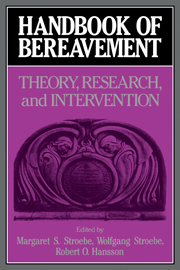Book contents
- Frontmatter
- Contents
- Contributors
- Preface
- Part I Introduction
- 1 Bereavement research and theory: An introduction to the Handbook
- Part II The phenomenology and measurement of grief
- Part III Current theories of grief, mourning, and bereavement
- Part IV Physiological changes following bereavement
- Part V The psychological, social, and health impacts of conjugal bereavement
- Part VI Grief reactions to different types of loss
- Part VII Coping, counseling, and therapy
- Part VIII Conclusions
- References
- Author index
- Subject Index
1 - Bereavement research and theory: An introduction to the Handbook
Published online by Cambridge University Press: 04 May 2010
- Frontmatter
- Contents
- Contributors
- Preface
- Part I Introduction
- 1 Bereavement research and theory: An introduction to the Handbook
- Part II The phenomenology and measurement of grief
- Part III Current theories of grief, mourning, and bereavement
- Part IV Physiological changes following bereavement
- Part V The psychological, social, and health impacts of conjugal bereavement
- Part VI Grief reactions to different types of loss
- Part VII Coping, counseling, and therapy
- Part VIII Conclusions
- References
- Author index
- Subject Index
Summary
The loss of a loved one is a tragedy unequalled by any other for most bereaved people. It is an experience that occurs some time or other in nearly everyone's life, and many suffer losses long before they reach old age, when such events occur with increasing frequency. According to statistics for the year 1985, more than 2 million people can be expected to die in a single year in the United States alone. Of these, more than 16,000 are children between the ages of 1 and 14, and as many as 38,000 are young people between the ages of 15 and 24 (U.S. Department of Health & Human Services, 1985). Such statistics also show alarming infant mortality rates, more than 40,000 babies dying before they reach the age of 1 year. For each of these deaths, bereaved persons are left behind - parents, spouses, children, siblings, and friends - all of whom are at high risk of detrimental effects on their mental and physical health.
If one looks beyond such statistics to consider world events, concern for the bereaved becomes hugely magnified. Natural disasters and human conflicts have devastated families in many nations during recent years. Frequently under such circumstances, grief over the death of a loved one is compounded by related tragedies, as when one person alone survives the loss of an entire family, when personal injury adds to suffering, when the violent or brutal death of a loved one has been witnessed, or when homes and livelihoods are also lost through the circumstances of war or other disaster.
- Type
- Chapter
- Information
- Handbook of BereavementTheory, Research, and Intervention, pp. 3 - 20Publisher: Cambridge University PressPrint publication year: 1993
- 15
- Cited by

